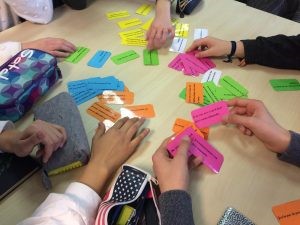4. How to use Europass with your clients
Students
First stage: raising awareness of international issues and working on the obstacles to mobility (1h)
Three exercises were proposed to students
First exercise: Get to know each other.
Simple questions are asked of the group and the students have to position themselves on one side or the other according to the answer. There is no right or wrong answer. Answers are subjective and students should respect each other in a positive atmosphere.
Example: "Those who speak German stand to the right":
This is repeated several times, asking about languages but also about travel habits (those who have already gone abroad, those who have already gone abroad this year, those who are going to go, those who have already gone outside Europe...).
Second exercise: Brainstorming.
The students are invited to think about the advantages of mobility and what it can bring them in the short, medium or long term. In turn, each student puts forward an idea that must be different from the others. For those who like competition, the young people can be made to sit down when they run out of ideas until the last one left standing.
Tip: it is important to make a note of the ideas that have been retained so that they can be summarised and used during the rest of the workshop.
Third exercise:
The students then work in groups of 5 on the issue of obstacles to mobility and the questions that it is important to ask before leaving. They are given a set of cards on which are written sentences evoking obstacles.
The set of cards was created as a result of interviews and workshops with high school students who were encouraged to express their feelings about the obstacles to going abroad.
Example of sentences:
I am not yet 18.
I will miss my family.
I don't know where to look for accommodation...

Photo of the cards
They look at these sentences and have to choose 2 or 3 each, the ones they think are the most important. Each group then explains their choices and why they chose certain phrases, the final objective being that the group retains only 5.
Each group presents the chosen obstacles, and the other groups are questioned to complete the list and to give direct suggestions for solutions to remove the obstacles.
The facilitator notes the key words on the board.
Note : The card game was created following almost 300 interviews and 5 workshops with high school students during which they worked on the obstacles to mobility and ways to overcome them.